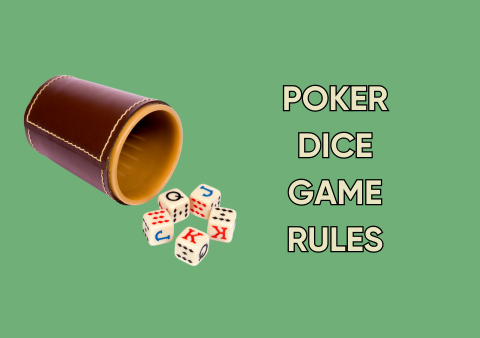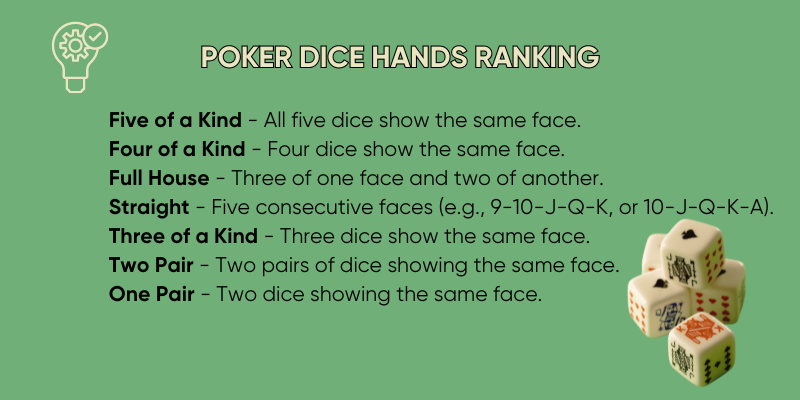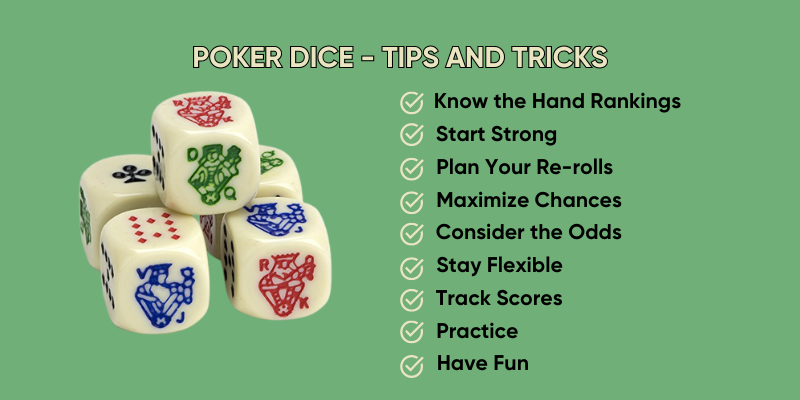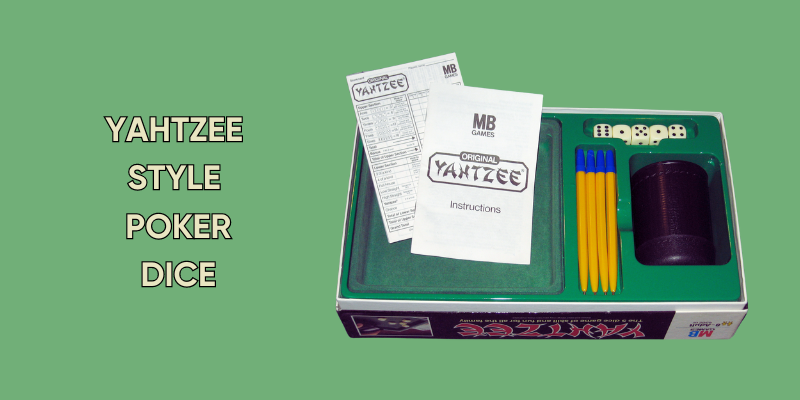
Poker Dice Game Rules
Poker Dice is a fun and easy-to-learn game, typically for two or more players, that combines the excitement of poker with the luck of dice rolling. In this article, we tell you all about Poker Dice game rules, including the equipment description, the game’s goal, the gameplay, examples, game variations, and even tips.
Poker Dice Game Rules – Needed Equipment
Understanding Poker Dice game rules can be relatively easy, especially with clear explanations and examples provided. You need some items to start.
Five Dice
Each die has faces showing Ace, King, Queen, Jack, 10, and 9 instead of the traditional pips (dots).
Score Sheets
To keep track of players’ scores.
The Poker with Dice Goal
The poker with dice aims to make the best possible poker hand using the dice. Players roll the dice and try to get combinations similar to those in poker.
Poker Dice Hands Ranking (from highest to lowest)

- Five of a Kind – All five dice show the same face.
- Four of a Kind – Four dice show the same face.
- Full House – Three of one face and two of another.
- Straight – Five consecutive faces (e.g., 9-10-J-Q-K, or 10-J-Q-K-A).
- Three of a Kind – Three dice show the same face.
- Two Pair – Two pairs of dice showing the same face.
- One Pair – Two dice showing the same face.
Poker Dice Game – Gameplay
Players sit around a table, and each player has a score sheet. Decide who will start the game. This can be done by rolling a single die, with the highest roll going first, or by any agreed method.
Taking Turns
- On their turn, a player rolls all five dice.
- After the first roll, the player may choose to keep any number of dice and re-roll the rest.
- The player can roll up to two more times, keeping any dice they wish after each roll, to make the best possible hand.
- The turn ends after the third roll or sooner if the player is satisfied with their hand.
Example of a Player’s Turn:
First Roll. The player rolls: 9, 9, Q, K, A. They decide to keep the two 9s (pair) and re-roll the Q, K, and A to improve their hand.
Second Roll. The player rolls: 9, 9, 10, J, 9. Now they have three 9s (Three of a Kind) and a chance for Four of a Kind. They decide to keep the three 9s and re-roll the 10 and J.
Third Roll. The player rolls: 9, 9, 9, K, K. The final result is a Full House (three 9s and two Kings).
Scoring
After the third roll (or sooner if the player is satisfied with their hand), the player’s score is determined based on the best poker hand they achieved. The score is recorded on the score sheet.
Winning the Game
After each player has taken their agreed number of turns, the scores are tallied. The player with the highest total score wins the game.
Poker Dice – Tips and Tricks
Follow these simple tips to improve your Poker Dice game.
✔️ Know the Hand Rankings
Learn the poker hands: Five of a Kind, Four of a Kind, Full House, Straight, Three of a Kind, Two Pair, and One Pair. Understanding these helps you decide which dice to keep and re-roll.
✔️ Start Strong
After your first roll, keep any matching dice or potential straights. For example, if you roll two 9s, keep them and aim for three or four of a kind.
✔️ Plan Your Re-rolls
Keep dice that could lead to higher hands. If you have a pair, try for Three of a Kind, Full House, or Four of a Kind. Adjust your strategy after each roll based on what you get.
✔️ Maximize Chances
If you roll a pair, keep it and re-roll the other three dice. Focus on securing a solid base (like Three of a Kind) before aiming for more complex hands (like Full House).

✔️ Consider the Odds
Know the chances of improving your hand. For example, getting the fifth matching die for Five of a Kind is 1 in 6. If you have part of a straight, remember that improving it is harder than enhancing a pair.
✔️ Stay Flexible
Be ready to change your plan based on what you roll. Sometimes it’s better to aim for a lower, safer hand. Adjust your strategy depending on your opponents’ scores.
✔️ Track Scores
Keep an eye on the scores to decide whether to take risks or play it safe.
✔️ Practice
Play often to get better at quick decisions and understanding probabilities. Try practice rounds to experiment with different strategies.
✔️ Have Fun
Enjoy the game and don’t get frustrated by bad rolls. Luck is a big part of the game.
Dice Poker Game Variations
Poker dice variants provide different ways to enjoy the game, each with unique rules that add depth and excitement to the traditional dice game. But if you are interested in other kinds of poker, you can also read about Pai Gow poker.
High Stakes Poker Dice
High Stakes Poker Dice adds a betting element to the traditional game, making it more strategic. Players start with a set amount of chips or money. Before each roll or round, players place bets based on the strength of their hand or their confidence in improving it. Betting continues until players complete their rolls.
The player with the best hand at the end of each round wins the pot. This variation introduces a psychological aspect, as players must decide whether to bet aggressively, call bets, or bluff.
Straight Poker Dice
In Straight Poker Dice, the goal is to roll a straight, which means five consecutive faces (e.g., 9-10-J-Q-K or 10-J-Q-K-A). Players roll five dice up to three times, trying to achieve a straight.
Unlike traditional Poker Dice, only straights count in this variation, and the highest straight wins. This version simplifies the game by focusing on one specific hand, making it quicker and easier for new players to learn.
Yahtzee-Style Poker Dice
Yahtzee-Style Poker Dice combines elements of Yahtzee with Poker Dice. Players have score sheets with various hand categories they must fill, such as Three of a Kind, Full House, Straights, etc. Each player takes turns rolling five dice up to three times, aiming to complete the categories on their score sheet.

Once a category is filled, it cannot be used again. The player with the highest total score after filling all categories wins the game. This game version adds a layer of strategy as players must decide the best use for each roll.
Bluff Poker Dice
Bluff Poker Dice introduces bluffing, similar to traditional poker. Players roll their dice in secret and can bluff about their hand. Other players can call the bluff or accept it. If a bluff is called and found to be false, the bluffer loses points. If the bluff is true, the caller loses points.
This variation adds a psychological element, as players must decide whether to trust their opponents or call their bluffs, making the game more interactive and suspenseful.
Pass the Dice Poker
In Pass the Dice Poker, players collaboratively build a hand, making the game more unpredictable. Players roll one die at a time and pass the dice around the table, each contributing to the final hand.
The goal is to create the best possible poker hand collectively. After all dice have been rolled, the hand is scored. This game variation fosters teamwork and adds a unique twist, as each player’s decision impacts the final outcome.
One-Roll Poker Dice
One-Roll Poker Dice simplifies the game by limiting players to a single roll. Players roll all five dice once, with no re-rolls allowed. The highest hand after one roll wins.
This variation is quick and straightforward, making it ideal for short games or for players who prefer a faster-paced version of Poker Dice.
Double Poker Dice
Double Poker Dice uses two sets of five dice, giving players more options to create a hand. Players roll both sets of dice and choose the best hand from the combined 10 dice. The player with the highest-ranking hand wins.
This version offers more complexity and opportunities for strategic decision-making, as players must decide which dice to use from a larger pool.
Elimination Poker Dice
In Elimination Poker Dice, players are gradually eliminated based on their hands. After each round, the player with the lowest hand is eliminated. The game continues until only one player remains.
This variation increases the stakes and adds a sense of urgency, as players must avoid being the lowest scorer to stay in the game.
Round-Robin Poker Dice
Round-Robin Poker Dice involves head-to-head matches between players. Players compete in pairs, with winners advancing to the next round.
The overall winner is the last player standing. This tournament-style variation adds competitiveness and structure, making it suitable for larger groups and more formal settings.
Poker Dice Game Rules – Summary
Poker Dice is a game where players roll five dice to make the best poker hand. They can roll up to three times per turn, aiming for combinations like Five of a Kind or Straight.
Variations include High-Stakes Poker Dice with betting, Straight Poker Dice focusing on straights, and Bluff Poker Dice, where players bluff about their hands. At the end of the game, the player with the highest score or the last one standing wins.
FAQ About Poker Dice Game Rules
What is Poker Dice game❓
Poker Dice is one of many poker variations where players roll five special dice, each marked with playing card faces instead of numbers, aiming to form the best possible poker hand based on traditional rankings.
How do you play Poker Dice❓
Players take turns rolling the dice up to three times per turn, aiming to make combinations like Five of a Kind, Four of a Kind, or a Straight.
What are the hand rankings in Poker Dice❓
Poker Dice hands rankings follow traditional poker rules, including Five of a Kind, Four of a Kind, Full House, Straight, Three of a Kind, Two Pair, and One Pair.
Are there different variations of Poker Dice❓
Yes, variations include High Stakes Poker Dice with betting, Straight Poker Dice focusing on straights, and Bluff Poker Dice where players bluff about their hands.
How do you determine the winner in Poker with Dice game❓
The player with the highest score at the end of the game or the last one standing in elimination-style variations wins.
How many players can participate in Poker Dice❓
Dice Poker can be played with two or more players, depending on the variation and preference.
Is Poker Dice suitable for all ages❓
Yes, Poker Dice is generally suitable for all ages, but parental discretion is advised for variations involving betting or bluffing.